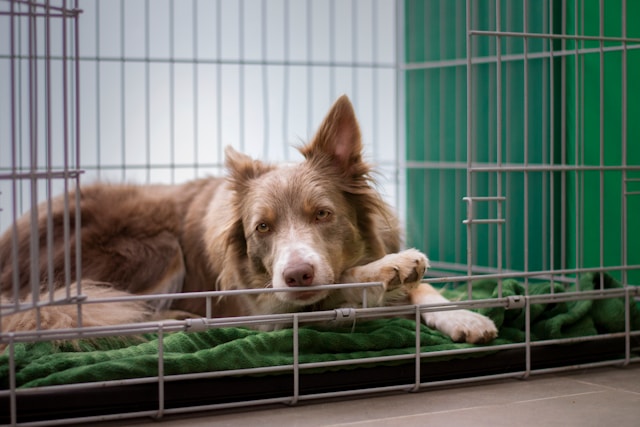What is Crate Training?
Crate training involves using a cage-like enclosure, often made of metal, plastic, or fabric, to manage your pet’s behavior. The idea is to create a safe and secure environment where the pet can relax, sleep, or spend short periods when you’re not able to supervise them. For dogs, crates are often used as a training tool, while for cats, they are typically used for transport or confinement during emergencies.
The Pros of Crate Training for Dogs
- Aids in House Training
- Crates help dogs learn bladder control as they are naturally reluctant to soil their sleeping area.
- Consistent crate training can speed up the process of housebreaking, reducing accidents in the home.
- Provides a Safe Space
- Dogs are den animals by nature, and a crate can mimic that den-like environment, offering them a safe retreat when they need it.
- A crate can provide a calm, quiet place for dogs to rest, away from the hustle and bustle of the household.
- Prevents Destructive Behavior
- When you’re unable to supervise your dog, a crate can prevent them from chewing on furniture, shoes, or other household items.
- It’s a safe way to confine a dog that tends to get into trouble when left alone.
- Helps with Travel and Vet Visits
- Crate-trained dogs are generally more comfortable traveling in a car, as the crate provides a familiar and secure place.
- They are also easier to handle during vet visits, reducing stress for both the pet and the owner.
- Useful During Recovery or Illness
- A crate can be a vital tool for keeping a dog calm and restricted during recovery from surgery or injury.
- It helps prevent excessive movement, jumping, or running, which can worsen an injury.
The Cons of Crate Training for Dogs
- Risk of Overuse
- One of the main cons is the potential for overuse, where dogs are confined for long periods, leading to physical and psychological issues.
- Dogs need exercise, social interaction, and mental stimulation; prolonged crating can lead to anxiety, depression, and behavioral problems.
- Potential for Misuse
- Crates should never be used as a form of punishment. Using a crate as a disciplinary tool can make the dog fear and resent the crate.
- Misuse can also occur when the crate is too small, too large, or placed in an area that’s too isolated.
- Training Challenges
- Not all dogs take to crate training easily. Some may feel anxious, and getting them comfortable with the crate may take time and patience.
- For some dogs, crate training can be a long, challenging process that requires consistent positive reinforcement.
- Can Increase Separation Anxiety
- For dogs prone to separation anxiety, crating can sometimes exacerbate the issue rather than solve it.
- These dogs may become more stressed in a confined space when left alone.
The Pros of Crate Training for Cats
- Easier Travel and Vet Visits
- A crate-trained cat is much easier to transport, whether going to the vet, traveling, or during emergencies.
- The crate serves as a safe and familiar place, reducing the stress of travel.
- Provides a Safe Refuge
- Crates can serve as a quiet, secure spot for cats during times of stress, like when guests are over or during home renovations.
- It can also be a place where cats retreat when they need alone time away from other pets or children.
- Helps with Managing Multi-Cat Households
- In multi-cat households, crates can be used to separate cats during feeding times or to give a sick or injured cat a quiet place to recover.
- They can also aid in the introduction process when bringing a new cat into the home.
- Facilitates Litter Box Training
- For kittens, a crate can help establish good litter box habits by limiting their access to other areas where they might have accidents.
- It also keeps them safe and contained when you can’t directly supervise them.
The Cons of Crate Training for Cats
- Cats May Resist Confinement
- Unlike dogs, cats are not natural den animals and often dislike confinement, making crate training more challenging.
- A cat that is not properly introduced to the crate can become stressed and associate it with negative experiences.
- Can Increase Stress and Anxiety
- Prolonged periods in a crate can cause anxiety in cats, particularly if they feel trapped or if the crate is associated with negative events like vet visits.
- Some cats may never fully acclimate to a crate, making the process more stressful than beneficial.
- Potential for Physical Discomfort
- Cats need to stretch, jump, and move freely. A cramped crate can lead to physical discomfort, especially if the cat is left inside for extended periods.
- Inadequate crate size or poor ventilation can also contribute to discomfort and stress.
- May Hinder Socialization
- Excessive crate time can hinder a cat’s socialization, as they may miss out on important interactions with people and other animals in the home.
- Cats that are confined too much may become withdrawn or exhibit behavioral issues.
How to Crate Train Your Dog or Cat: Tips for Success
- Choose the Right Crate
- Select a crate that is appropriately sized for your pet—large enough for them to stand, turn around, and lie down comfortably but not too large that they feel lost inside.
- Ensure the crate is well-ventilated, secure, and comfortable. For cats, add a soft blanket and familiar-smelling items.
- Make the Crate Inviting
- Place the crate in a quiet, low-traffic area of your home where your pet can feel safe.
- Add comfortable bedding, toys, and treats to create a positive association with the crate.
- Introduce Slowly
- Don’t rush the process. Allow your pet to explore the crate at their own pace.
- Encourage them with treats and praise when they go near or enter the crate on their own.
- Use Positive Reinforcement
- Reward your pet every time they enter the crate, even if it’s just for a short time.
- Never force your pet into the crate; it should be a place they choose to go willingly.
- Gradually Increase Crate Time
- Start by crating your pet for short periods while you are at home, gradually increasing the time as they become more comfortable.
- Always leave the door open when you’re around so your pet can enter and exit freely.
- Never Use the Crate as Punishment
- The crate should always be a positive space. Never use it as a way to discipline your pet.
- Using the crate as punishment can create negative associations and make the training process much harder.
- Monitor Your Pet’s Behavior
- Pay attention to signs of stress, anxiety, or discomfort while your pet is in the crate.
- If your pet shows signs of distress, reduce crate time and try to make the space more inviting.
- Keep Sessions Short and Positive
- Avoid leaving your pet in the crate for extended periods, especially during the initial training stages.
- Crate training should be a gradual process; patience is key.
Final Thoughts: Is Crate Training Right for Your Pet?
Crate training can be a valuable tool for managing the behavior of both dogs and cats, but it’s not without its challenges. The decision to crate train should be based on your pet’s temperament, needs, and your ability to commit to training properly. While crates can provide safety, security, and aid in training, they should never replace proper exercise, socialization, and interaction.
When done correctly, crate training can offer numerous benefits for both pets and owners. However, it’s essential to avoid overuse and always prioritize your pet’s comfort and well-being. If you have concerns about crate training, consult with a veterinarian or a professional trainer to develop a plan that works best for your pet.











Leave a Reply